Struggling to turn content into real business results? This content strategy guide breaks down how to plan, create, and scale content that actually works.
What is Content Strategy
Ever felt like your content is all over the place—blogs here, emails there, and no real plan? That’s exactly what a content strategy fixes.
In simple terms, content strategy is your master plan. It tells you what content to create, who it’s for, where it goes, and what it’s supposed to do. Think of it like GPS for your content—without it, you’re just driving in circles.
It answers the big question: What do you say? Who cares?
And how do you say it in a way that works for your brand and your audience?
Why is Content Strategy Important
Let’s say you launch a product, but no one clicks, reads, or buys. That’s what happens when you skip strategy. Without a content strategy, your message might sound nice, but it won’t hit home.
A good content strategy keeps your content useful, consistent, and goal driven. It turns one-off efforts into a smart, connected experience. In fact, brands with a documented strategy are over 300% more likely to succeed, according to the Content Marketing Institute.
So yes—it’s not just important. It’s the difference between noise and impact.
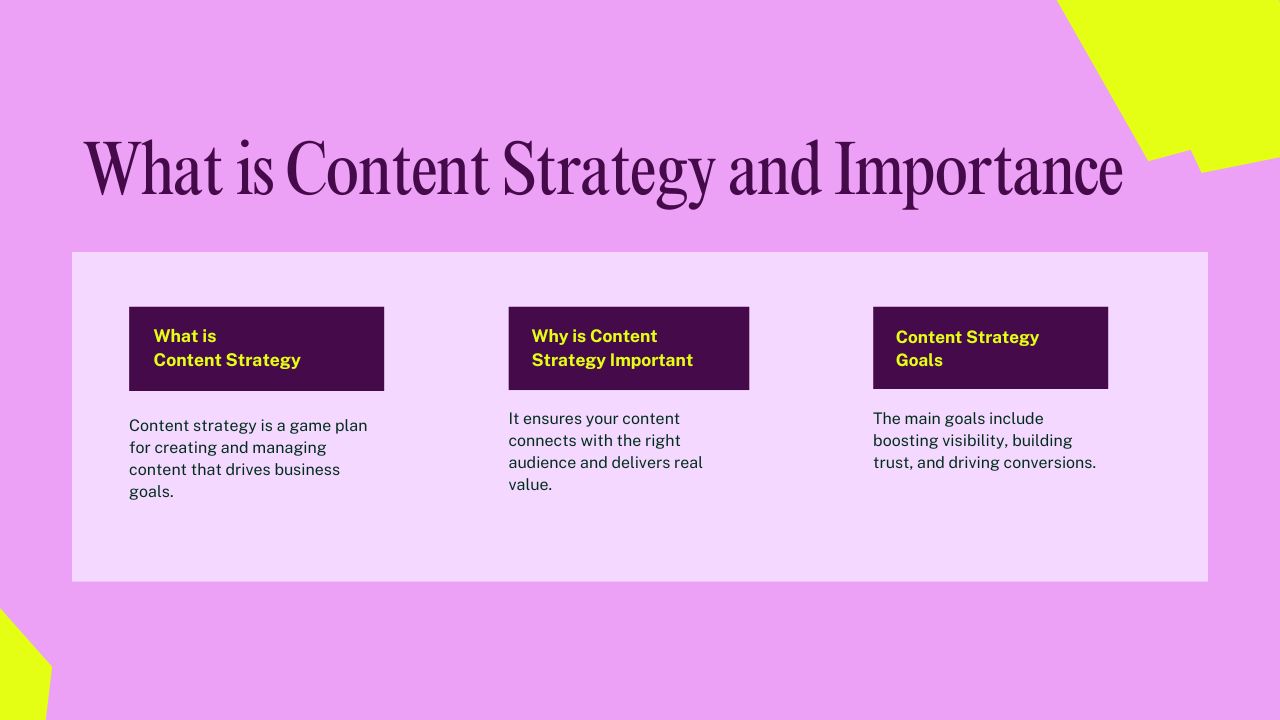
Content Strategy Goals
Every content strategy has clear goals—it’s not just writing for the sake of it.
Are you trying to drive traffic? Get leads? Keep customers coming back?
All these can be goals.
The trick is to tie content goals to business goals. For example, if your sales team wants more qualified leads, your blog strategy should support that.
In the end, your content strategy helps you focus your energy and measure what matters—like growth, engagement, or conversions.
Creating a Content Strategy Plan
Steps to Develop Content Strategy
So, where do you start?
The first step in building a content strategy is figuring out your endgame.
Ask yourself: What do I want this content to achieve?
Then work backward. Research your audience, audit existing content, define your messaging, and set your goals. It’s like assembling IKEA furniture—you need all the pieces before it makes sense.
And don’t worry if it’s messy at first. The goal is progress, not perfection.
Building a Content Strategy
Now comes the fun part—connecting the dots. This is where you take your research and turn it into action.
You map out what content to create, when to publish it, and how it supports your goals. It’s part planning, part creativity, and part detective work.
Imagine building a playlist for your audience—every piece should have a purpose, a vibe, and fit the mood.

Creating a Content Strategy That Aligns with Business Goals
Here’s where many folks go wrong—they treat content like a side project. But great content strategy starts with your business goals.
Let’s say your business wants more sign-ups. Your content plan should include lead magnets, SEO blogs, or how-to guides. If you’re focusing on customer retention, maybe it’s newsletters or user tips.
The content you create should work with your business, not just sit on the sidelines. That’s the power of strategic alignment.
Research: Foundation of a Strong Content Strategy
Understand Your Business Environment
Before you start writing or designing anything, pause and zoom out.
What’s happening inside and outside your company?
Look at your competitors, your market, and your own team.
Are there gaps? Trends? Opportunities? Maybe your competitor’s blog ranks high because they’ve covered topics you’ve ignored.
This step helps you know where you stand—and where your content strategy needs to go next.
Learn About Your Audience and Users
Let’s be honest—creating content without knowing your audience is like texting someone without knowing their number. It just won’t land.
So, talk to your users. Run surveys, read reviews, or check what questions they’re Googling.
What are they struggling with? What tone do they like?
This research fuels everything—from the topics you choose to the voice you write in. Think of it as your content compass.
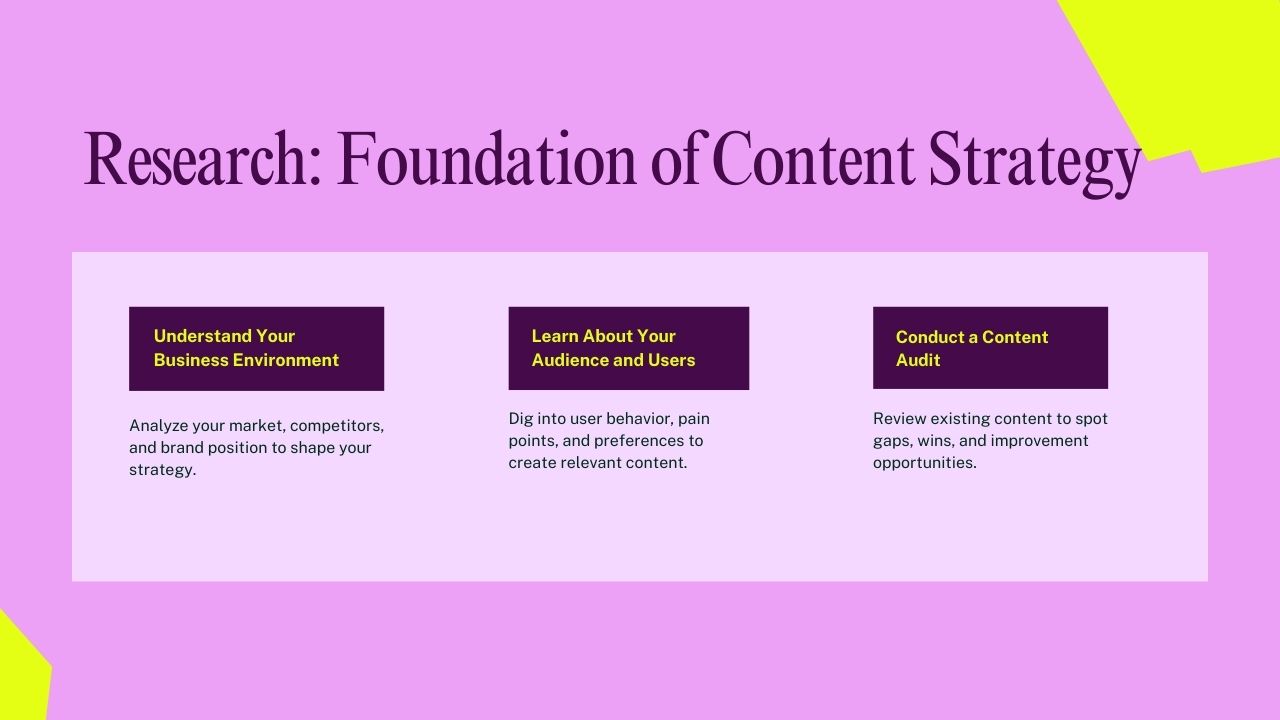
Conduct a Content Audit
Now, turn the lens inward. A content audit is basically a check-up for your existing content. You’ll go through your blog posts, videos, web pages, and emails to see what’s working—and what’s not.
Is anything outdated? Repetitive? Or worse, invisible on search? A good audit helps you spot gaps and avoid doubling your efforts.
Once done, you’ll know exactly what to keep, update, or toss—and how to better support your content strategy moving forward.
Content Strategy for SEO and Structure
Content Strategy for SEO
Let’s say you write an amazing blog post—but no one finds it. That’s where SEO steps in. A solid content strategy for SEO makes sure your content gets seen and clicked.
It starts with keyword research. Find out what your audience is searching for, then create content that answers those questions. Add internal links, headings, and meta tags to guide both users and Google.
Good SEO isn’t just about rankings—it’s about creating content that’s useful, discoverable, and built to last.
Content Design and Structure
Now let’s talk about structure. Even great ideas fall flat if the content is messy. Structure helps readers scan quickly and stay longer.
Use clear headings, short paragraphs, and bullet points where it helps. Organize your content so it flows like a story—from hook to value to CTA.
And design matters too!
A clean layout, visuals, and proper formatting can turn dry info into something people actually want to read.
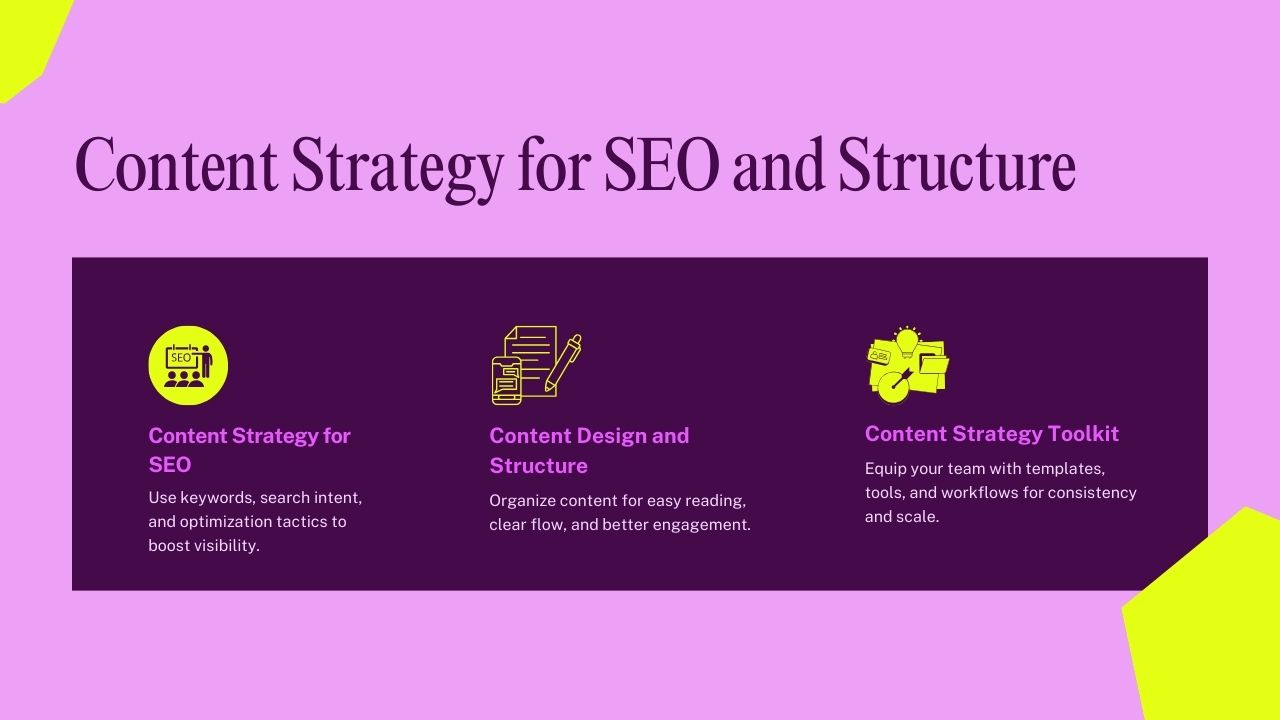
Content Strategy Toolkit
Think of this as your content strategy survival kit. It includes tools like editorial calendars, SEO checklists, content briefs, and templates.
These tools keep everyone—from writers to designers—on the same page. They also save time and reduce chaos.
Use platforms like Trello for planning, Google Docs for collaboration, and tools like SEMrush or Ahrefs for SEO insights. With the right toolkit, your content strategy runs smoother and smarter.
Implementing and Measuring Content Strategy
Create On-Strategy Content
Now it’s showtime—time to bring your strategy to life. But don’t just create content for the sake of it. Make sure every piece aligns with your goals and speaks to your audience.
This is called on-strategy content. It means writing with purpose. If your goal is brand awareness, maybe that’s a blog series. If it’s lead generation, maybe it’s an eBook or a landing page.
Use your content strategy toolkit here—templates, tone guides, SEO briefs. These keep your content consistent and impactful.
Measure Content Strategy Success
Ever published a post and wondered, “Did that actually work?”
That’s where measuring comes in. And no—it’s not just about page views.
Track metrics that match your content strategy goals.
Want engagement? Look at time on page or shares. Chasing leads? Check form fills or conversions.
Set KPIs before you create, not after. This helps you improve, not just report. Over time, you’ll know exactly what’s working—and what needs a tweak.
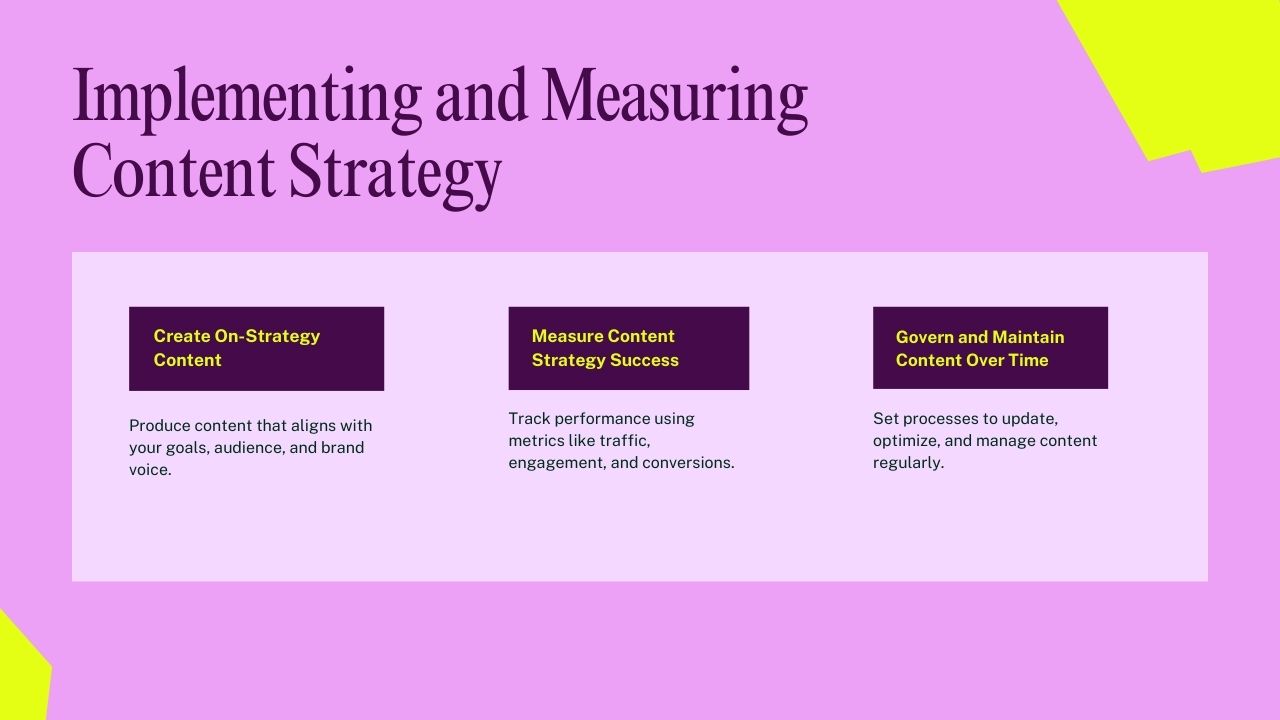
Govern and Maintain Content Over Time
Think of content like a garden. You can’t just plant and forget. You need to water it, prune it, and sometimes replant.
That’s where governance comes in. Define roles for content owners, create review cycles, and plan for updates. Your strategy isn’t a one-and-done doc—it’s a living system.
Set reminders to refresh old content. Review what’s still performing. With regular care, your content will keep growing strong.
Content Strategy Examples and Use Cases
Examples of Content Strategy
Let’s get practical. Here are a few real-world content strategy examples that prove the power of doing it right.
AppSumo, a SaaS platform, implemented a comprehensive content strategy focusing on SEO and valuable tutorials. This approach led to an 843% increase in organic traffic and a 340% boost in revenue.
Contour, a UK-based eCommerce brand, revitalized its website with a full content and SEO strategy. The result? Organic traffic surged by 2,000%, transactions increased by 1,200%, and revenue exceeded £2 million.
Content strategy works when it’s built around clear goals and the audience’s real needs.
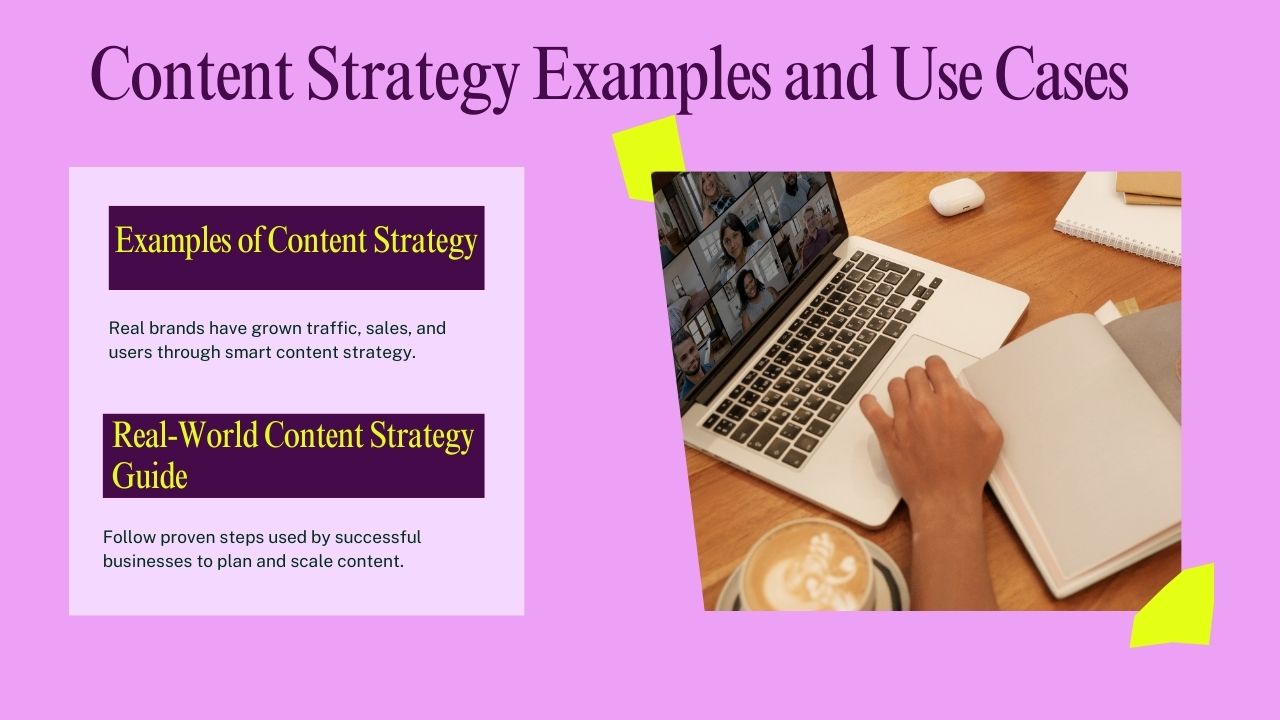
Real-World Content Strategy Guide
Every business is different, but the playbook stays the same. Here’s a simple guide you can tweak for your own brand:
- Set your goals. Know why you’re creating content.
- Understand your people. Dive deep into user needs.
- Audit and plan. Check what’s working, map out the rest.
- Design smart content. Use SEO, structure, and brand voice.
- Track and evolve. Measure results, update content, repeat.
That’s your roadmap. Whether you’re building a content strategy from scratch or just leveling up what you have—stick to these steps.
And remember: great content strategy doesn’t just fill space. It drives results, builds trust, and grows your brand long-term.


Leave a Comment